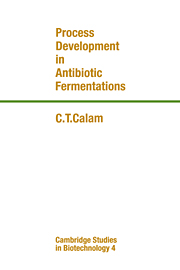Summary
Reviewing the field of antibiotic process development, it can be seen to be a mixture of chance, biochemical and physiological understanding, and the adaptation of a biological process to a physical framework defined by the fermentation equipment.
In wild strains, antibiotic production forms part of the system of differentiation that lies behind the cycle of growth and reproduction; it is usually associated with the end of vegetative growth and the onset of sporulation. Such a rigid system is unsuited to development, and the initial stages of mutation and selection have the effect of loosening this linkage so that antibiotic production starts to extend over a longer period of growth. Thus, at this stage, production often appears to be growth linked and to be associated with a particular phase of growth that must be extended as long as possible. Later on in development, growth and production become relatively independent, and production can be maintained over a long period, giving very high production levels. This often requires that the cells be grown in a particular form of pellets, enabling the productive phase to be held for many days.
There are two obvious limitations to high levels of production, first the supply of oxygen for energy production (and possibly for the maintenance of a favourable aerobic balance in the cells), second the inhibitory effect of the antibiotic and of other products in the fermentation. With wild strains, many substances are inhibitory, such as phosphate, but many of these effects are lost in mutation. Glucose, however, usually remains inhibitory to antibiotic production.
- Type
- Chapter
- Information
- Process Development in Antibiotic Fermentations , pp. 200 - 201Publisher: Cambridge University PressPrint publication year: 1987

